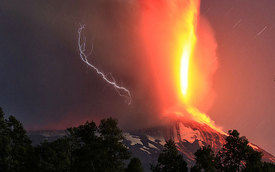 Activity at Villarica on Monday 3rd March 2015. Activity at Villarica on Monday 3rd March 2015. A recent period of unrest at Villarica developed spectacularly on the morning of the 3rd of March with a transition to lava fountaining. This eruptive episode has been covered extensively in the media because of the fantastic display and successful evacuation of nearby residents. Usually, Villarica has a relatively stable lava lake at the summit, with occasional mild strombolian activity. Occasionally, the volcano sees more vigorous periods of activity, such as that which occurred on the 3rd of March. One of the major questions surrounding all volcanic activity is: what controls the transitions between different styles of activity? This applies both on longer timescales of years to decades and even centuries but also on shorter ones of seconds to minutes and hours. The latter consideration is my particular area of interest. In a video of activity leading up to the main lava fountain (see video half way down the page), we can see that smaller strombolian like explosions seem to increase in frequency and vigor leading up to the lava fountain (indeed patterns have been noticed in strombolian activity at Etna - a shameless plug of some of my own work). Could this pattern be analysed to predict the occurrence of a lava fountain before it occurs? How could we do this? The answer lies in monitoring gas emissions - a difficult task at night and during more ash rich eruptions! The transition between strombolian type activity and Hawaiian occurs when magma rise speed is high enough such that it prevents the coalescence of bubbles (which are rising at a slower rate than the magma) which drive strombolian style activity when bubbles grow to a large enough size(see this paper by Parfitt and Wilson). 7/3/2015 08:16:20 am
The comparison with Etna is very fitting, where in the past four years alone we have seen more than 40 similar episodes - "paroxysms" as they are often called - and many of them went through a similarly rapid transition from Strombolian activity to sustained lava fountaining. This latest episode at Villarrica has stricken all of us at Etna because it was so amazingly similar - except for the lack of lava flows, which occur in nearly all of Etna's paroxysms. Gas emissions seem to be only partly helpful, in that we often but not always see an increase in SO2 emissions, days or sometimes up to a week before a new eruptive episode, and sometimes there is an increase in SO2 emission but no significant eruptive activity ensues. Take also GPS and maybe InSAR and tiltmetry, and you might see some very slight inflation a few hours to a couple of days between a paroxysm. Seismic activity - foremost, volcanic tremor - increases essentially along with the eruptive activity, so that there is not very much of precursory seismic activity (no earthquakes in any case at open-conduit volcanoes like Villarrica or Etna). Since a few years, new algorithms are applied at Etna, which for instance constantly "scan" the volcanic tremor signal - that is, digital data - looking for systematic changes in the character of the signal, and often "see" changes before humans can see them by looking at the tremor graphs or spectrograms. It would be fascinating to see some of these techniques applied at volcanoes like Villarrica, and see where there are differences and/or things in common with Etna.
Tom Pering
12/3/2015 02:08:17 am
Thanks for you comment Boris. A very interesting insight into the intriguing system at Etna. I agree it would certainly be fascinating to compare a whole range of measurements between the two volcanoes - which I am sure would provide an insight into the similarities (and differences of course) between the two systems. Comments are closed.
|
Archives
July 2023
|

 RSS Feed
RSS Feed